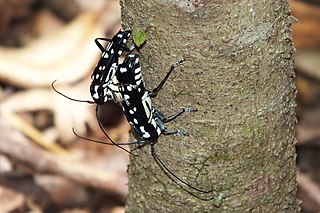Related Research Articles

Glenealy is one of the few roads or streets without a suffix in Hong Kong. Located in the Mid-Levels on the Hong Kong Island, Hong Kong, it starts from Ice House Street and goes uphill to Hong Kong Zoological and Botanical Gardens, across Robinson Road and ends at Hornsey Road and Conduit Road.

The R752 road is a regional road in County Wicklow, Ireland. From its junction with the R772 in Rathnew on the outskirts of Wicklow Town it takes a generally south-westerly route to its junction with the R747 in the village of Woodenbridge, where it terminates.

Glenealy is a village 8 km (5.0 mi) west of Wicklow Town, in County Wicklow, on the R752. The Dublin - Rosslare railway line also passes through the village.
Glenealy can mean:
The Flores tiger is a species of nymphalid butterfly in the Danainae subfamily. It is endemic to Flores, Indonesia.

Griposia is a genus of moths of the family Noctuidae.
The 2005–06 All-Ireland Senior Club Hurling Championship was the 36th staging of the All-Ireland Senior Club Hurling Championship, the Gaelic Athletic Association's premier inter-county club hurling tournament. The championship began on 30 October 2005 and ended on 17 March 2006.

Glenealy Hurling Club is a Gaelic Athletic Association club located in the parish of Glenealy and Ashford in County Wicklow, Ireland. The club was founded in 1885 as a football club but switched codes to the game of hurling in the early 1920s.

Glenea is a genus of longhorn beetles belonging to the family Cerambycidae, subfamily Lamiinae.
Falsozeargyra wegneri is a species of beetle in the family Cerambycidae, and the only species in the genus Falsozeargyra. It was described by Stephan von Breuning in 1963.

Glenea venus is a species of beetle in the family Cerambycidae. It was described by James Thomson in 1865. It is known from Papua New Guinea, Australia and Indonesia.
Glenea albolineata is a species of beetle in the family Cerambycidae. It was described by James Thomson in 1860.
Glenea algebraica is a species of beetle in the family Cerambycidae. It was described by James Thomson in 1857. It is known from Borneo, Malaysia, Java and Sumatra.
Glenea chlorospila is a species of beetle in the family Cerambycidae. It was described by Charles Joseph Gahan in 1897. It is known from Taiwan and Japan.
Glenea lineata is a species of beetle in the family Cerambycidae. It was described by Charles Joseph Gahan in 1897.
Glenea glaucescens is a species of beetle in the family Cerambycidae. It was described by Per Olof Christopher Aurivillius in 1903 and is known from Sulawesi.
Glenea jordani is a species of beetle in the family Cerambycidae. It was described by Lepesme and Stephan von Breuning in 1952.

Glenea elegans is a species of beetle in the family Cerambycidae. It was described by Olivier in 1795, originally under the genus Saperda. It is known from Malaysia, Thailand, Sumatra, and Java.

Glenea dimidiata is a species of beetle in the family Cerambycidae. It was described by Johan Christian Fabricius in 1801. It is known from Malaysia and Indonesia.
Oreomylodon is an extinct genus of ground sloth in the family Mylodontidae, endemic to Ecuador during the Pleistocene. The only species, O. wegneri, was long considered to be either a species or subgenus of Glossotherium or a junior synonym of Glossotherium robustum, but studies of its cranial anatomy published in 2019 have supported Oreomylodon as a valid genus, and suggested it is more closely related to Paramylodon. However, a subsequent analysis published in 2020 again sunk Oreomylodon wegneri into Glossotherium, as a distinct species. It shows adaptations to living in a high-altitude habitat, and its fossils have frequently been unearthed in the Interandean Valles of Ecuador, at elevations of between 2,450 and 3,100 meters.
References
- ↑ BioLib.cz - Glenea wegneri. Retrieved on 8 September 2014.